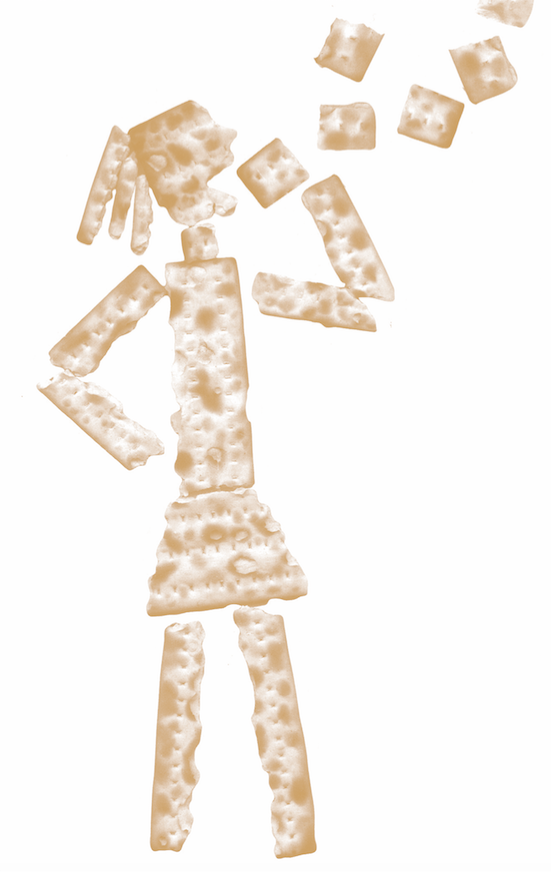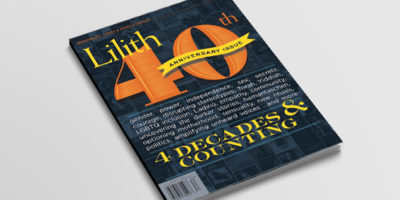
from “All Who Are Hungry”
Feasting again, a college student uses Passover to celebrate her freedom from the slavery of anorexia. [Spring 2000]

Art: Laurie Douglas
Judaism teaches us to sanctify the significant moments in our lives with rituals, and thus it seems appropriate to me to mark the beginning of my recovery from anorexia with some sort of rite of passage. Last spring, in preparation for Passover, I was struck by several parallels between the symbols and images of the seder and my own emotions as I come to develop a more healthy attitude toward food and eating. Now, I am ready to create my own seder—a seder that will be not just a feast of freedom, but a joyous celebration of the freedom to feast once again.
For two years, I have been enslaved to the insidious illness termed anorexia nervosa. I have tortured my body in pursuit of an elusive ideal of thinness; I have driven myself like an Egyptian taskmaster to run five miles at the crack of dawn each morning; I have been haunted by images of food pyramids in a strange land where hunger burns in my body yet I dare not consume. My enslavement has been cruel and isolating, but I have been delivered by the strong hands and outstretched arms of doctors, nurses, family and friends who heard my cries of suffering and showed me the way to freedom.
It is with this newfound freedom that I call out the words of the ha lachma anya, the symbolic invitation recited near the beginning of the seder: “Let all who are hungry come enter and eat; Let all who are in need come and celebrate Pesach.” I am free to say that I, too, have been hungry and I, too, deserve to eat. After months of eating nothing but cottage cheese and fruit in the privacy of my bedroom, I can now gather around the table with my family and friends and rejoice communally. Eating is no longer an activity that sets me apart from other people, but a means of reconnecting with those I love most. And so when the tzimmis and stuffing and turkey and potatoes are handed to me, I do not pass them over from the sister at my left to the sister at my right. I realize that it is not just the first time that I am eating hot food again, but also the first time that I feel the warmth that comes from eating at the table together.
But just as the seder directs us, I remember that there are thousands of others out there who cannot or will not satisfy their hunger. Up to 20% of those who suffer from anorexia die of related causes before they can accept that they are in need. So at my seder, I entreat all those who are hungry to listen to their hunger and to feed their bodies and their souls. Let all who are hungry come eat.
I know how it feels to be hungry. I have struggled with the competing voices in my mind: There is the wise child, who reminds me that only if I allow myself to eat can I live a full and meaningful life. The wicked child, who insists that food is an enemy and eating a sign of weakness and laziness. The simple child, who longs for a world without food so she will not have to think about calories and fat. And finally, the child who does not know how to ask, who cannot cry out in need because she refuses to listen to her own hungers and insists that her physical needs do not matter.
The objects on the seder plate remind me to celebrate all that matters. The zeroa [shank bone] is a reminder that I was once little more than a pile of bones.
The leafy green karpas reminds me that every year provides an opportunity for rebirth and renewal—I can rebuild my life in spite of the damage I have inflicted on my body in the past. The egg, too, is a symbol of fertility, a reminder that if I feed myself, I will be able to raise a family of my own. The haroset and maror remind me that to live life fully we must taste both the sweet and the bitter moments. To close our mouths to both is only to hide from life; to open our mouths, as we do at the seder, is to allow ourselves to taste and sing and praise.
Judaism is not a religion of asceticism and self-denial; I am not holy because I can subsist on mustard and carrots alone. Although we sing dayenu, “it is enough,” today I affirm the opposite: It is not enough. It has not been enough to eat only what is absolutely necessary for survival.
I have read that no one ever recovers fully from an eating disorder, and my own struggle continues each day. But the seder is a celebration not of the arrival at the promised land, but of the freedom to journey.


